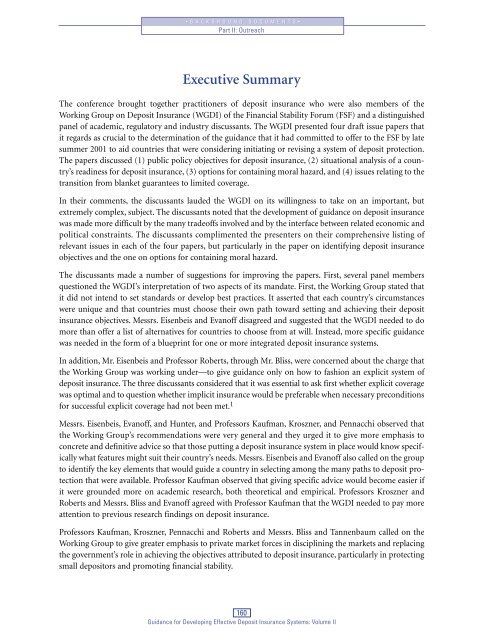Volume II - PDF - International Association of Deposit Insurers
Volume II - PDF - International Association of Deposit Insurers
Volume II - PDF - International Association of Deposit Insurers
- No tags were found...
You also want an ePaper? Increase the reach of your titles
YUMPU automatically turns print PDFs into web optimized ePapers that Google loves.
•BACKGROUND DOCUMENTS•<br />
Part <strong>II</strong>: Outreach<br />
Executive Summary<br />
The conference brought together practitioners <strong>of</strong> deposit insurance who were also members <strong>of</strong> the<br />
Working Group on <strong>Deposit</strong> Insurance (WGDI) <strong>of</strong> the Financial Stability Forum (FSF) and a distinguished<br />
panel <strong>of</strong> academic, regulatory and industry discussants. The WGDI presented four draft issue papers that<br />
it regards as crucial to the determination <strong>of</strong> the guidance that it had committed to <strong>of</strong>fer to the FSF by late<br />
summer 2001 to aid countries that were considering initiating or revising a system <strong>of</strong> deposit protection.<br />
The papers discussed (1) public policy objectives for deposit insurance, (2) situational analysis <strong>of</strong> a country’s<br />
readiness for deposit insurance, (3) options for containing moral hazard, and (4) issues relating to the<br />
transition from blanket guarantees to limited coverage.<br />
In their comments, the discussants lauded the WGDI on its willingness to take on an important, but<br />
extremely complex, subject. The discussants noted that the development <strong>of</strong> guidance on deposit insurance<br />
was made more difficult by the many trade<strong>of</strong>fs involved and by the interface between related economic and<br />
political constraints. The discussants complimented the presenters on their comprehensive listing <strong>of</strong><br />
relevant issues in each <strong>of</strong> the four papers, but particularly in the paper on identifying deposit insurance<br />
objectives and the one on options for containing moral hazard.<br />
The discussants made a number <strong>of</strong> suggestions for improving the papers. First, several panel members<br />
questioned the WGDI’s interpretation <strong>of</strong> two aspects <strong>of</strong> its mandate. First, the Working Group stated that<br />
it did not intend to set standards or develop best practices. It asserted that each country’s circumstances<br />
were unique and that countries must choose their own path toward setting and achieving their deposit<br />
insurance objectives. Messrs. Eisenbeis and Evan<strong>of</strong>f disagreed and suggested that the WGDI needed to do<br />
more than <strong>of</strong>fer a list <strong>of</strong> alternatives for countries to choose from at will. Instead, more specific guidance<br />
was needed in the form <strong>of</strong> a blueprint for one or more integrated deposit insurance systems.<br />
In addition, Mr. Eisenbeis and Pr<strong>of</strong>essor Roberts, through Mr. Bliss, were concerned about the charge that<br />
the Working Group was working under—to give guidance only on how to fashion an explicit system <strong>of</strong><br />
deposit insurance. The three discussants considered that it was essential to ask first whether explicit coverage<br />
was optimal and to question whether implicit insurance would be preferable when necessary preconditions<br />
for successful explicit coverage had not been met. 1<br />
Messrs. Eisenbeis, Evan<strong>of</strong>f, and Hunter, and Pr<strong>of</strong>essors Kaufman, Kroszner, and Pennacchi observed that<br />
the Working Group’s recommendations were very general and they urged it to give more emphasis to<br />
concrete and definitive advice so that those putting a deposit insurance system in place would know specifically<br />
what features might suit their country’s needs. Messrs. Eisenbeis and Evan<strong>of</strong>f also called on the group<br />
to identify the key elements that would guide a country in selecting among the many paths to deposit protection<br />
that were available. Pr<strong>of</strong>essor Kaufman observed that giving specific advice would become easier if<br />
it were grounded more on academic research, both theoretical and empirical. Pr<strong>of</strong>essors Kroszner and<br />
Roberts and Messrs. Bliss and Evan<strong>of</strong>f agreed with Pr<strong>of</strong>essor Kaufman that the WGDI needed to pay more<br />
attention to previous research findings on deposit insurance.<br />
Pr<strong>of</strong>essors Kaufman, Kroszner, Pennacchi and Roberts and Messrs. Bliss and Tannenbaum called on the<br />
Working Group to give greater emphasis to private market forces in disciplining the markets and replacing<br />
the government’s role in achieving the objectives attributed to deposit insurance, particularly in protecting<br />
small depositors and promoting financial stability.<br />
160<br />
Guidance for Developing Effective <strong>Deposit</strong> Insurance Systems: <strong>Volume</strong> <strong>II</strong>
















